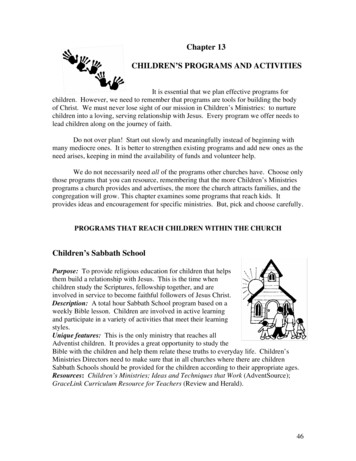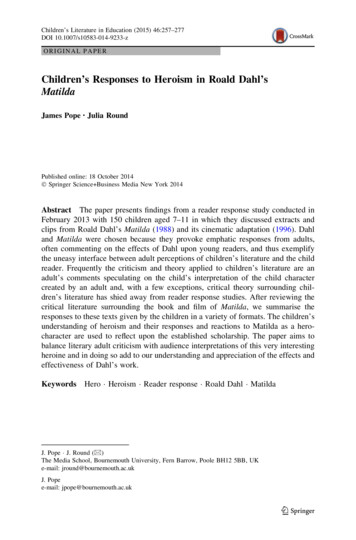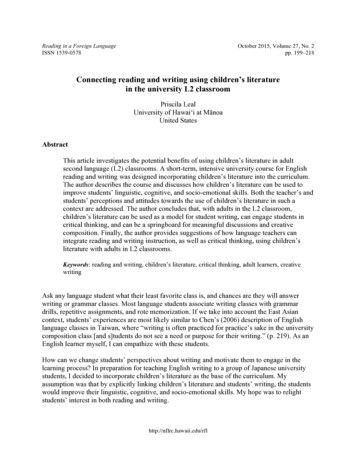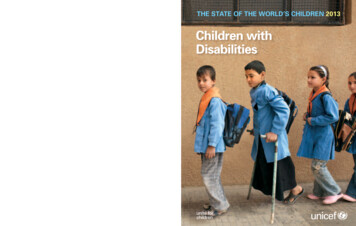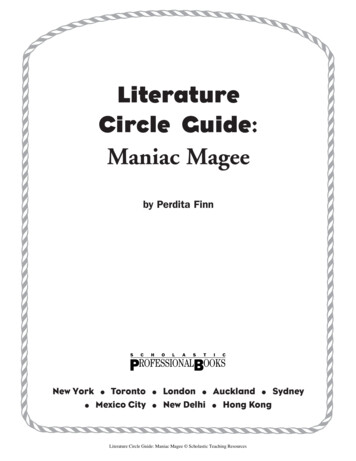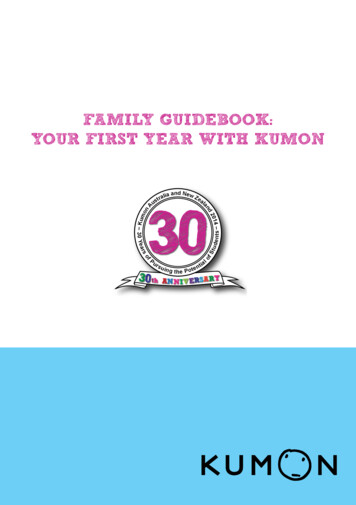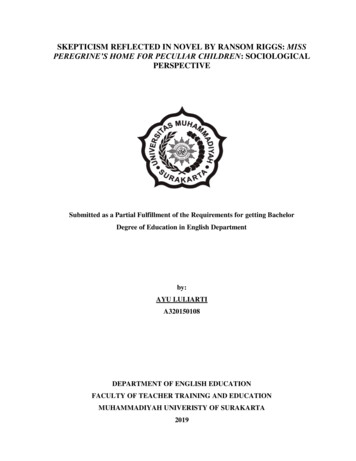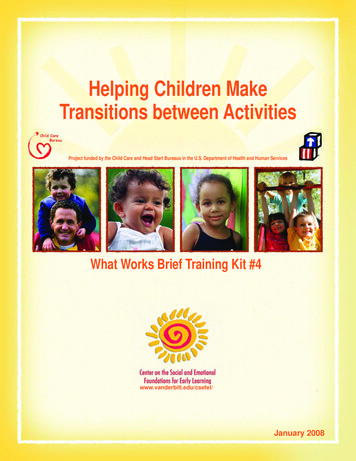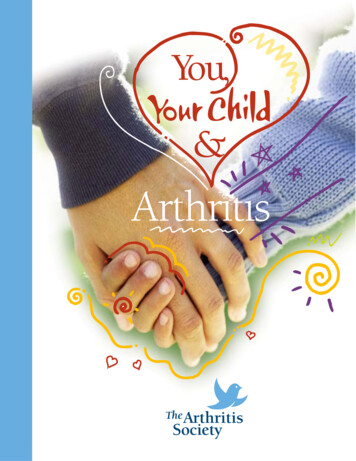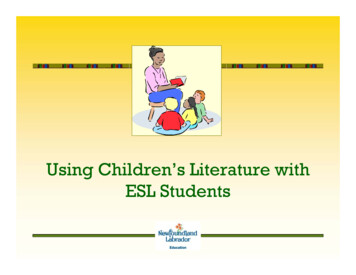
Transcription
Using Children’s Literature withESL Students
Contents of Presentation Why Use Children’s Literature? Interactive Read Aloud––––PreparationPre-ReadingDuring Reading InteractionsPost-Reading (Follow-up activities) Questions and Comments
Good pictures are as close to universallanguage as the world is likely toget picture books are an invaluableaid to communication across linguisticlines.Reid, 2002, p. 35
Read-aloud provides an opportunity tosimplify text, use gestures, expression,and intonation to aid comprehension andengagement.
Why Use Children's Literature? Natural and engaging language experience Engagement for multilevel and multi-agegroups Universal themes Simple language Manageable story length Illustrations Vocabulary in context Skills and strategies development
Why Use Children’s Literature? (cont’d .) Integration of language skills: reading,listening, speaking, writing Heightened interest in books and reading Cultural knowledge (Western and othercultures) Multicultural stories – students see themselves Text to self discussion – may lead to openingup about students’ experiences Exposure to literary terms and appreciation ofliterature
Why Use Children’s Literature? (cont’d .) Figurative language and cultural metaphorsContent linksVisual art appreciationSpringboard for follow-up activitiesFUN !
K- 6 ESL BeginnersLanguage in context, language rich experienceListening, Speaking, Reading, WritingBasic VocabularyCross-curricular outcomesOral language developmentConcepts about printFoundation for reading strategiesRepetitive and predictable textSimple sentence structureLots of possibilities for extension activitiesEnjoyable and engaging
Multi-age and multilevel groups8-18 year olds
Preparationfor Interactive Read-Aloud Read the book several times. Consider a limited number of specificoutcomes. Select words for vocabulary focus. Consider pre-reading. Consider interactive comprehension questionsor prompts. Consider specific interactive questions orprompts to support outcomes. Consider after-reading activities to supportcontent and language outcomes.
Pre-Reading Activities Generate prediction based on the coverpicture and title. Encourage students to bring their ownexperiences. Read author and illustrator names. Read the inside flap and author info foradolescent students. Introduce some key vocabulary needed forcomprehension. Encourage students to figureout the meaning through illustrations andcontext.
DuringInteractive Read Aloud children do not learn fromdemonstration by passively absorbinginformation. To learn, children mustbecome engaged with thedemonstration.Barrentine, 1996, p. 38
Small Group DiscussionList some purposes forinteracting with students duringthe read-aloud.
Why interact?1. Interact to engage students2. Interact to check or extendcomprehension3. Interact to teach strategies4. Interact to teach vocabulary5. Interact to teach about stories
Interacting with “Fire on the Mountain”In the high and beautifulmountains of Ethiopia there oncelived a dreamer named Alemayu
1. Interact to engage students“Someday,” he said aloud to thesheep, “I will have a bag of money.”– Heighten interest byasking listeners to predict.“Do you think he will havea bag of money?”– Affirm success by askingbeginners to find an objectin the illustration.– Ask questions to guidecomprehension.
2. Interact to check or extend comprehensionThat evening Alemayu’s sister kissedhim, and Alemayu set out with onlya shemma wrapped around him andhis flute in his hand –“Where does Alemayuhave to go?”–“What can he take withhim?”–“How do you thinkAlemayu is feeling?”
3. Interact to teach strategiesAll night long the rich man ate and drankand talked of how strong he was, howbrave There was nothing to hear but thesound of his own boasting.– Look at pictures tounderstand: “Whatis the rich mandoing?”– Construct meaningsin context: “Whatdoes boast mean?”– Read, think;re-read, think.
4. Interact to teach vocabularyFor example: Make a short list on the boardbeforehand. The goal is to learn some newwords, not every new word inthe story. Focus on vocabulary words thatmay be useful, most common(and revisit). During the reading, focus onwords that are crucial tounderstanding the rnbraveboasting
5. Interact to teach about storiesHigh in the mountains the winddanced and screamed throughthe rocks He began to shiverso hard he could hardly think.“In a story we oftenfind a challenge,something difficult forthe main character todo.”“What challenge doesAlemayu have?”
Post-Reading ActivitiesMaintaining the self-confidence of eachreader should be a top priority at thispoint for continued learning.Reid, 2002, p. 27
Small Group DiscussionList some post-reading activities.
Re-readingRead the book again or have stronger readersread it to the group. Start the next class with anon-stop reading.Re-reading: Reinforces vocabulary Consolidates language structures Builds listening skills Enhances comprehension Bolsters ability to do follow-up activities
Word focus, e.g: Animals (sheep, baboon,ibis, hyena, cows, mule) Words for anger (rage, fury,foul temper) Amharaic words (shemma,injera, wat, mesob, kraretc.):This is a nice focus for amainstream class – and makesome Ethiopian food! Have students identify theirown words for exploration.sheepmulehyenaAnimalsibisbabooncowWild AnimalsTame Animals
Other Suggested Post-Reading Activities Retell (orally with a partner or in writing)Create student-made questionsDraw a picture, label, show and tellMake a time line (start from scratch or putevents in order)Describe an illustrationDiscuss, write a commentary on the art workCreate and perform readers’ theatreCarry out an author study and read otherbooks by the author
after reading . Discuss the mood of the writing and how the authorcreates the mood Find words and sentence that create a scary/happy/sad feeling Describe a personal experience using some of thefeeling words Match adjectives to characters and discuss Create a Venn diagram of character traits Discuss and write about character motivation Role play the characters in a specific circumstance Write a poem about a character
Let students guide the activity; let themcome up with activities that interest themand were triggered by the readingexperience. Be flexible – grasp the teachablemoment. Use children’s literature as a catalyst forstudents’ personal writing.
Students can listen to stories read aloud on internetsites. Here’s one:http://www.storylineonline.net/There are many websites for teachers which provideactivities related to specific popular children’s books.
Questions? Comments?
References Barrentine, S. (1996) Engaging with reading through reading through interactiveread-alouds, Reading Teacher, 50/1, 36-43.Brown, E. Using Children's Literature with Young Learners, (2004)The InternetTESL Journal, 10/2. Retrieved online Dec.29, 2008 htmlKhodabakhshi, S. C. and Lagos, D.C. (1993) Reading Aloud: Children's Literaturein College ESL Classes, The Journal of Imagination in Language Learning andTeaching, 1. Retrieved Dec. 29, 2008, online athttp://www.njcu.edu/cill/vol1/lagos.htmlMorton, C. J. Catching the Bug for reading Through Interactive Read-Alouds. ReadThink Write, International Reading Association. Retrieved online Dec. 29, 2008 athttp://www.readwritethink.org/lessons/lesson view.asp?id 241Smallwood, B. (1998) Using Multicultural Children's Literature in Adult ESLClasses. National Clearinghouse for ESL Literacy Education Washington DC ERICIdentifier: ED427557, Retrieved on line Dec. 10, 2008 athttp://www.ericdigests.org/1999-4/using.htm
The Department of Education, Newfoundland and Labrador, 2009
books by the author. after reading . Discuss the mood of the writing and how the author creates the mood Find words and sentence that create a scary/happy/ . in College ESL C
